
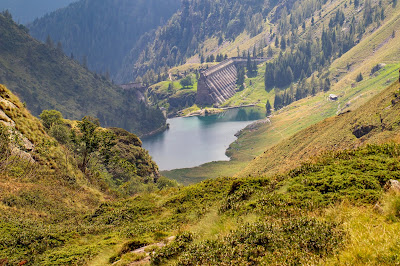
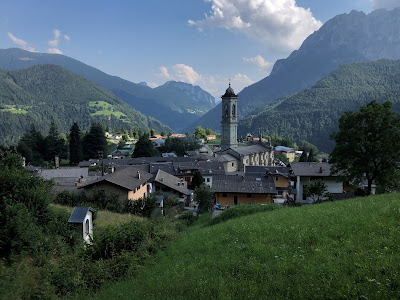

Upper left: A member of the Asteraceae family in the process of sending it's seeds. Upper right: The Gleno Dam from above. Lower left: The village of Vilminore in Val di Scalve. Lower right: Trail 410 in the Val di Gleno.
Overview
Length: 22.2 km (13.8 mi)
Duration: 9 hours (Includes 1 hour for lunch at the rifugio.)
Elevation: 2290 m (7510 ft) gain. High point at Passo Belviso at 2518 m (8260 ft)
Location: Pian del Gleno, Vilminore di Scalve, Bergamo, Lombardy, Italy
Hike Details
We were advised not to take Sentiero 411 – Sentiero 410 (via Val di Gleno) to the Rifugio Tagliaferri but rather to take the more popular Sentiero 413 (via Valle del Vò). We were glad we stuck to our original idea because Sentiero 411 seemed to be the less popular route, which for us was a good thing. And, Sentiero 411 is about the same in time and distance.
The hike worked out like this:
- We started in Vilminore and took the shuttle up to Pianezza.
- If you are off-season, you can try and drive up to Pianezza and park.
- Or, you can start walking in Vilminore.
- From Pianezza, we took Sentiero 411 to the dam.
- From the dam, we picked up Sentiero 410 to Passo Belviso.
- From Passo Belviso, we picked up Sentiero 321 to Rifugio Tagliaferri.
- Lunch at Tagliaferri.
- Reverse direction and head back to Pianezza/Vilminore.

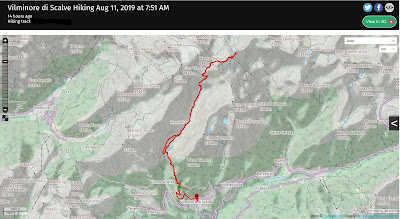
Left: Hike stats: distance, velocity, time and altitude. Right: The hike route in the Val di Gleno.
A note on the shuttle bus:
We started in Vilminore and parked the car in one of the many free lots. From there, we took a small shuttle (navetta) up to Pianezza, where we started hiking. You can also hike right out of Vilminore by walking up to Pianezza following the road or taking one of the trails marked “Diga del Gleno”. We walked back down the road from Pianezza to Vilminore at the end of the day and it wasn’t bad. The shuttle costs 4 euros one way. We purchased tickets at Bar Imperial and the shuttle stop is at the municipio across the street from the bar. Why take a shuttle instead of driving up to Pianezza? During the summer months, only residents are allowed and you must take the shuttle. Off season, and you don’t need to worry. On our way up to the dam – around 8:00 am – it wasn’t crowded at all, that is, no people on the shuttle, few hikers, and few people at the lake except for some overnight campers. When we returned in the afternoon, the tents on the lake where gone and replaced by many families up to enjoy Sunday at the lake. And there was a waiting line for the shuttles back going from Pianezza down to Vilminore, which is why we walked.
There was a small refreshment stand / bar on the lake. After that, there is nothing until you reach Rifugio Tagliaferri. The Rifugio is named for Nani Tagliaferri, the first president of the Valle di Scalve chapter of CAI. Tagliaferri, the person, disappeared in 1981 in the glaciers of the Peruvian Andes. Tagliaferri, the rifugio, was inaugurated in 1985.




Some of the dishes a Rifugio Tagliaferri. Left to right: a simple pasta dish, salamella with polenta, lamb with polenta, and homemade apple cake.
The Gleno Dam
The central part of the dam collapsed early on the first of December 1923. From 1535 m (5,036 ft), the water rushed out finding its way to the north end of Lago Iseo at approximately 186 m (610 ft) and killing more than 350 people along the way. What went wrong? The dam had just been completed not more than four months before, but there were warning signs along the way from the quality of the cement and reinforcement used to a change in the type of dam permitted and type build. The last point is interesting because the Gleno Dam was permitted as a gravity dam but during construction which was changed from a gravity dam to a multiple-arch dam. A gravity dam relies on its weight to hold back water. A multiple-arch dam uses less concrete and relies on distributing the force of the water to the arches (buttresses) on both sizes of the dam. It’s these arches that give the Gleno Dam its captivating look as if it were of ancient Roman origin. But sadly, it wasn’t or else it would probably still be standing. Cost cutting to save concrete and reused scrap metal from WWI inside the concrete likely led to its collapse.
However, a very thorough analysis (in Italian) Il crollo della Diga di Pian del Gleno: Errore Tecnico? suggests that situation was much more complicated and that the dam was built to specifications of the time. Further, many of the allegations of bad cement or reused scrap metal may not have much to do with the collapse. The analysis also discusses the evidence supporting the possibility of sabotage, including the theft of dynamite two days before the collapse. The court case ran from 1924 to 1927 and found the owners and many others involved guilt, with compensation for damages to the survivors.
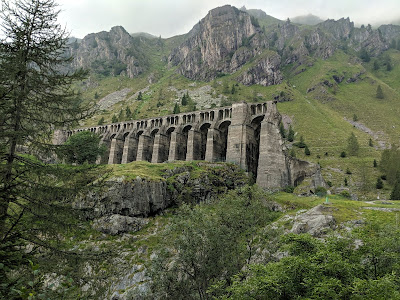





Views of the Gleno Dam (La Diga del Gleno) which collapsed in 1923.
An interesting point raised in the report is that the dam was planned to provide energy for a cotton factory. At one time, the valleys above Bergamo were filled with industry run by the water. Today, as you drive up the valleys, in this case Val Seriana and then into the Val di Scalve, you can’t help but notice along the road (which stays close to the river) the hulking abandoned factories that speak to that past. Some of the structures are beautiful examples of industrial architecture.
Another point from the analysis was this disturbing sentence: “L’ondata fu preannunciata da un violento spostamento d’aria che iniziò l’opera di distruzione, strappando le vesti a chi si trovava all’aperto, seguita dalla massa d’acqua che, dopo aver devastato I centri abitati della valle, si esaurì nell ago d’Iseo.” The translation is this: “The wave was preceded by a violent rush of air before the destruction, ripping off the clothes of those who were outdoors. The rush of air was followed by a mass of water that, after ravaging the population centers of the valley, found its way to the top of Lago Iseo.” The ripping-off of the clothes part stuck in my mind. In the report, there is a picture of the victims laid out in a room - presumably by the responders to the disaster - some with bits of cloth or twigs and branches discretely placed over private parts.
To this day, we’ll never know what caused the dam to collapse.

Information board at the dam talking about the collapse.
Flora
If we had to pick one plant that characterized this hike, it would be Sanguisorba. It is a genus of flowering plants in the family Rosaceae native to the temperate regions of the Northern Hemisphere. The common name is burnet. We guess we were seeing the most common type S. dodecandra – Italian Burnet (Salvastrella con dodici stami).
For more on flowers found around Bergamo, especially in the Bergamasque Alps, see our Pinterest page: Bergamasque Prealps Flowers and Plants.
Usual disclaimer: we use the resources listed in the post Resources for Identifying Plants around Bergamo to identify plants shown here. If we had to give ourselves a score for identifications, it would be 95% accurate for species and 98% for genus.
The plants are arranged below as follows:
[Family] Genus species – Common name in English (Common name in Italian)
[Amaryllidaceae] Allium schoenoprasum – Wild Chives (Erba cipollina)
![[Amaryllidaceae] Allium schoenoprasum – Wild Chives (Erba cipollina) [Amaryllidaceae] Allium schoenoprasum – Wild Chives (Erba cipollina)](https://blogger.googleusercontent.com/img/b/R29vZ2xl/AVvXsEhnmZchCBlK110l088fvE9TZBQC5G4uUNaSMcePdy691jzMIuZYx8-DkseZNN6tZlhCwboFa6Vu1_xHbbJ9PDqKfJNAuIVZVkkUI0IHDY-6OrDOcEKX376hPh3yfH6BbMW3KtswELMnFs8/s400/%255BAmaryllidaceae%255D+Allium+schoenoprasum+%25282%2529.jpg)
![[Amaryllidaceae] Allium schoenoprasum – Wild Chives (Erba cipollina) [Amaryllidaceae] Allium schoenoprasum – Wild Chives (Erba cipollina)](https://blogger.googleusercontent.com/img/b/R29vZ2xl/AVvXsEhNBVrlVa05Rj8oT6hsmeKzG1cMiC-1j0dLsZx781brrMcFuutjo4Pa_pW9zleh3jTDvroZJFYx1YYTXx55ZiCep6-kl3c7c8n3ai2YzjqlamCQFcCLLu361l3tgrFwH44qqzVB6JlqDZ0/s400/%255BAmaryllidaceae%255D+Allium+schoenoprasum.jpg)
For more on flowers found around Bergamo, especially in the Bergamasque Alps, see our Pinterest page: Bergamasque Prealps Flowers and Plants.
Usual disclaimer: we use the resources listed in the post Resources for Identifying Plants around Bergamo to identify plants shown here. If we had to give ourselves a score for identifications, it would be 95% accurate for species and 98% for genus.
The plants are arranged below as follows:
[Family] Genus species – Common name in English (Common name in Italian)
[Amaryllidaceae] Allium schoenoprasum – Wild Chives (Erba cipollina)
![[Amaryllidaceae] Allium schoenoprasum – Wild Chives (Erba cipollina) [Amaryllidaceae] Allium schoenoprasum – Wild Chives (Erba cipollina)](https://blogger.googleusercontent.com/img/b/R29vZ2xl/AVvXsEhnmZchCBlK110l088fvE9TZBQC5G4uUNaSMcePdy691jzMIuZYx8-DkseZNN6tZlhCwboFa6Vu1_xHbbJ9PDqKfJNAuIVZVkkUI0IHDY-6OrDOcEKX376hPh3yfH6BbMW3KtswELMnFs8/s400/%255BAmaryllidaceae%255D+Allium+schoenoprasum+%25282%2529.jpg)
![[Amaryllidaceae] Allium schoenoprasum – Wild Chives (Erba cipollina) [Amaryllidaceae] Allium schoenoprasum – Wild Chives (Erba cipollina)](https://blogger.googleusercontent.com/img/b/R29vZ2xl/AVvXsEhNBVrlVa05Rj8oT6hsmeKzG1cMiC-1j0dLsZx781brrMcFuutjo4Pa_pW9zleh3jTDvroZJFYx1YYTXx55ZiCep6-kl3c7c8n3ai2YzjqlamCQFcCLLu361l3tgrFwH44qqzVB6JlqDZ0/s400/%255BAmaryllidaceae%255D+Allium+schoenoprasum.jpg)
[Caryophyllaceae] Cerastium arvense – Filed Chickweed (Peverina dei campi)
[Celastraceae] Parnassia palustris - Marsh Grass of Parnassus (Parnassia delle paludi)
![[Celastraceae] Parnassia palustris - Marsh Grass of Parnassus (Parnassia delle paludi) [Celastraceae] Parnassia palustris - Marsh Grass of Parnassus (Parnassia delle paludi)](https://blogger.googleusercontent.com/img/b/R29vZ2xl/AVvXsEhWitAYox6L660IoqzZSrS5AlWI7ekSatukmNew5aR_RZUfr1otlDEEIyns-rVbMqsuEOTsGRoaXtkQg70V0-VcazrLUHhLRDzRV1L5N-Ako4pMmXtiivmtCu2jFQXsM4PyTEJveKrRQO4/s400/%255BCelastraceae%255D+Parnassia+palustris.jpg)
[Crassulaceae] Rhodiola rosea – Roseroot Stonecrop (Rodiola rosea)
![[Crassulaceae] Rhodiola rosea – Roseroot Stonecrop (Rodiola rosea) [Crassulaceae] Rhodiola rosea – Roseroot Stonecrop (Rodiola rosea)](https://blogger.googleusercontent.com/img/b/R29vZ2xl/AVvXsEgXFMVtt1YT6ugvgiDWzps0mEZJcouAOjaJAj5-OHkkRee69RUNJj6guFPFfzsxiSzycvRYjAL3Avi7eb2ec7G-TdrNYamy9s-LXtu2vBtGfEavgqY4X5Orh3v5ABXDseqJQv_OnBqQB3I/s400/%255BCrassulaceae%255D+Rhodiola+rosea+2.jpg)
![[Crassulaceae] Rhodiola rosea – Roseroot Stonecrop (Rodiola rosea) [Crassulaceae] Rhodiola rosea – Roseroot Stonecrop (Rodiola rosea)](https://blogger.googleusercontent.com/img/b/R29vZ2xl/AVvXsEhxrHd-H9Ie_z-CsKKTgkFIZLIi4KGyAXsu0-T7v4ptv5mooaLA_SZYjZ3_GLFavj8t9PjRgzrSQg2JJu3a-Zq7-4-Ohn9nvEvPyXmCha0wML4q8bHr7FNVtxZkyN9tsPF0qkO-ByBd6KY/s400/%255BCrassulaceae%255D+Rhodiola+rosea.jpg)
[Rosaceae] Potentilla nitida – Pink cinquefoil (Cinquefoglia delle Dolomiti)
[Ranunculaceae] Pulsatilla alpina – Alpine Pasqueflower (Pulsatilla alpina)
[Saxifragaceae] Saxifraga byroides – Mossy Saxifrage (Sassifraga briode)
![[Saxifragaceae] Saxifraga byroides – Mossy Saxifrage (Sassifraga briode) [Saxifragaceae] Saxifraga byroides – Mossy Saxifrage (Sassifraga briode)](https://blogger.googleusercontent.com/img/b/R29vZ2xl/AVvXsEhVHm34SgQkiZRx8YpX9JEXXau3jRvpPI1beK1hRSsS1_aA7HscJ8AZwQl3h8s6jArKzJ0pzoWfb4-699Ursk_T5qc-2hX-YlnrQ8O-nYTF0vu4sBwBVtkpuYNFjSHPKES8d8aLhJRCpeA/s400/%255BSaxifragaceae%255D+Saxifraga+byrodes.jpg)
![[Saxifragaceae] Saxifraga byroides – Mossy Saxifrage (Sassifraga briode) [Saxifragaceae] Saxifraga byroides – Mossy Saxifrage (Sassifraga briode)](https://blogger.googleusercontent.com/img/b/R29vZ2xl/AVvXsEjcW4ikcm3lW_6qv82HdVGP2ReONB5G6nNJHAfHAGK8EShrAq_4K1uJYlvApss8tAnRvkut8-rQ37_RwGEA0trTeXigTxB9SWbws-P04slcg1nqCU1WRlqzkNU_YuuuN0Ie78Yzo_ALMls/s400/%255BSaxifragaceae%255D+Saxifraga+byroides+2.jpg)
Miscellaneous Shots of the Hike

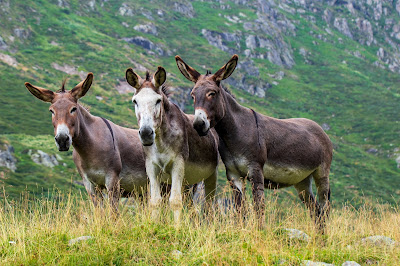

Left and center: Donkeys (or are they mules!?) eye us suspiciously. Right: Walking up the Val di Gleno.



Left: The trail along the Gleno River. Center: On Passo Belviso - A view of Lago Belviso. Right: View toward Presolana.
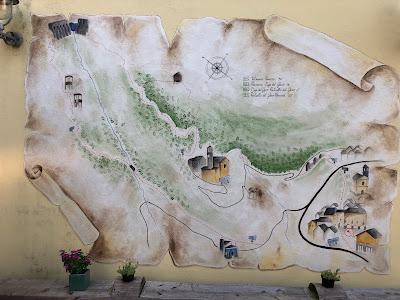


Left: A mural in Vilminore showing trail to the Gleno Dam. Center: A war monument in Castione della Presolana. Right: Vilminore - Parrocchia S. Maria Assunta e S. Pietro Apostolo.
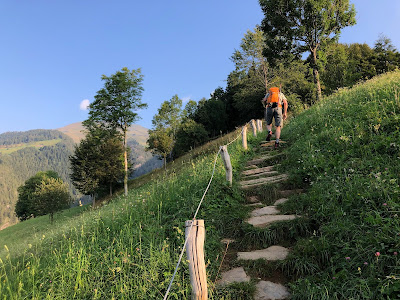


Left: The start of the trail, just above Pianezza. Center: Trail 411 from Pianezza to the Gleno Dam. Right: Trail near Passo Belviso.
![[Apiaceae] Bupleurum petraeum – Rock Hare’s Ear (Bupleuro delle rocce) [Apiaceae] Bupleurum petraeum – Rock Hare’s Ear (Bupleuro delle rocce)](https://blogger.googleusercontent.com/img/b/R29vZ2xl/AVvXsEiJnfAI66makFglYRwLYGe0U9WSpWTdK-bPhgTJ8gmGM73F3AHF0Pz1j13Pc0a_6nh5dtFgK2Y1d_BVtD9P-Kb9B47Gn8Ol9KYlxUJ26IDXdhai44GfI9agOR9a6RVO20bibxGXvui_3bA/s400/%255BApiaceae%255D+Bupleurum+petraeum+%25282%2529.jpg)
![[Apiaceae] Bupleurum petraeum – Rock Hare’s Ear (Bupleuro delle rocce) [Apiaceae] Bupleurum petraeum – Rock Hare’s Ear (Bupleuro delle rocce)](https://blogger.googleusercontent.com/img/b/R29vZ2xl/AVvXsEi_dSMjcaehejsbJsvr7hq27qWFvKV39SYU58UPKboOtshEizJBWIv52NPnKShLljSkeIPqj7eKmHrTx_wIeFkXJsYKcz7IBMyXpK9pEzyY9VbfJaUsEZmF5Iqct8vfn-aDiSYC0MHzmHE/s400/%255BApiaceae%255D+Bupleurum+petraeum.jpg)
![[Asteraceae] Carlina sp. [Asteraceae] Carlina sp.](https://blogger.googleusercontent.com/img/b/R29vZ2xl/AVvXsEiofOuiU_Vgs4J4JbXyWRRxyKsS7M_ZffWO3h1A38wgh0YEXICEzkIxSwNj21sykkwn318q9l4XprvDN-azELEyys44CNzNaqA6vdoXfLdj0vzzor9dB4WOMesS9srWu-Q8ImaXCa2mIs8/s400/%255BAsteraceae%255D+Carlina.jpg)
![[Asteraceae] Centaurea uniflora - Plume Knapweed (Fiordaliso alpino con un capolino) [Asteraceae] Centaurea uniflora - Plume Knapweed (Fiordaliso alpino con un capolino)](https://blogger.googleusercontent.com/img/b/R29vZ2xl/AVvXsEgAEWfz9CLR9w4p6FEWyWvrRWCYOs0QEA-6tpLRKlKpN_E-z-s2T-Ga2ctaEUpbBBqrRWviqAV1FRaKtzeKLrehOA8Pdd8zDxC6tUkqJZlB-DvZgJKH-gfxn0AK2Oefi-bzjK84pDR13hg/s400/%255BAsteraceae%255D+Centaurea+uniflora.jpg)
![[Asteraceae] Cirsium erisithales – Yellow Thistle (Cardo zampa d'orso) [Asteraceae] Cirsium erisithales – Yellow Thistle (Cardo zampa d'orso)](https://blogger.googleusercontent.com/img/b/R29vZ2xl/AVvXsEijdg-A8MZZ9xxwq37xvKj88MzqaYw1d-z5eOTsEYMh5IuiF7dJZCeL1pEbmz88gf4RHMJzWtubgxQ-k90__NrtkFhor8YNfpo8BxuYN_DWdB_c_BEE5ra5onAedXDHH6SmkWdlm1pi0uo/s400/%255BAsteraceae%255D+Cirsium+erisithales.jpg)
![[Asteraceae] Cirsium spinosissimum - Spiniest Thistle (Cardo spinosissimo) [Asteraceae] Cirsium spinosissimum - Spiniest Thistle (Cardo spinosissimo)](https://blogger.googleusercontent.com/img/b/R29vZ2xl/AVvXsEhcNojY-dLR1m8lqN15aVZWDbT-yf2J48XogDaWZDH-0HJTLd3x7hL9AAc4rVvB1LubidlJkqLWZfZjlvjU8PRMWLsIY2rXdrL6KwrnVPDVqFNxYcjjTsl9Bj7-TlVW7FBAQyGTbVqDP_U/s400/%255BAsteraceae%255D+Cirsium+spinosissimum.jpg)
![[Asteraceae] Crespis aurea – Golden Hawk's Beard (Radicchiella aranciata) [Asteraceae] Crespis aurea – Golden Hawk's Beard (Radicchiella aranciata)](https://blogger.googleusercontent.com/img/b/R29vZ2xl/AVvXsEjYITScofvh1B_xqKo11aFQJRl09u-_mJbEd69opmRdJ7Wm9glNpRJMw06L4tPyNPnWUx-xh8UaaacpDx0KV4Ex22eqjsldzJsd9h3rM4cTM_wJR7SJDwadQ13nDG5c59LhDJOyg3IMy10/s400/%255BAsteraceae%255D+Crespis+aurea.jpg)
![[Asteraceae] Leontopodium sp. – Edelweiss (Stella alpina) [Asteraceae] Leontopodium sp. – Edelweiss (Stella alpina)](https://blogger.googleusercontent.com/img/b/R29vZ2xl/AVvXsEjGOIVmG6jqT6HvpmA2nWv2sCm0JyeHdjorYSVddmeTCbLfupfwCW_-Bi0MvR0G_xLctggdwqZJ9t1DGbQErQ28LUeAmYpyciKLVRKBJn4yz_6DsGubhklbQZinh5OuKHAiWdzxckR4I2c/s400/%255BAsteraceae%255D+Leontopodium.jpg)
![[Boraginaceae] Eritrichum nanum – Arctic Alpine Forget-me-Not (Eritrichio nano) [Boraginaceae] Eritrichum nanum – Arctic Alpine Forget-me-Not (Eritrichio nano)](https://blogger.googleusercontent.com/img/b/R29vZ2xl/AVvXsEh8p9gEB5kI8VXA9jlLiSk8NrqqmryZsmC2gat_ey9lIjakwZmWC0CuCX_tHZSOiVPNdybZhoeW_bkWbR3ibRqr8JU9P6T9QTH80Zk6VsaGUrdVi2WYQF737ygoAVJFNvEjuOV791qUtQA/s400/%255BBoraginaceae%255D+Eritrichum+nanum+2.jpg)
![[Boraginaceae] Eritrichum nanum – Arctic Alpine Forget-me-Not (Eritrichio nano) [Boraginaceae] Eritrichum nanum – Arctic Alpine Forget-me-Not (Eritrichio nano)](https://blogger.googleusercontent.com/img/b/R29vZ2xl/AVvXsEiMplRDhpLLW00p2C7iGxLrf306qTKaexPLBCoBOJtGThlhtlM-d0SByHJYqmYqERivNjs4Yy3HiArX5r_Awj9Z8zPJIcJZWHngMNVfq4jm-ob02jmZ5UjEKkweiWPh3eQU1D8zXUtrsXA/s400/%255BBoraginaceae%255D+Eritrichum+nanum.jpg)
![[Brassicaceae] Noccaea rotundifolium – Round Leaved Penny Cress (Erba storna a foglie rotunda) [Brassicaceae] Noccaea rotundifolium – Round Leaved Penny Cress (Erba storna a foglie rotunda)](https://blogger.googleusercontent.com/img/b/R29vZ2xl/AVvXsEgzT5TcVNdQbt9jZ9R2tsontLSsvIm2vpLQpAQWiMcOWvbShN_OpUYZBkhHNh_tNwnujtlsuSqdx2l5ZbBtw4_XwEz958AKaMSycNJXfPIHfy2rL8ihfUmcIVbEnPe60K7GWISJGA0K6Ws/s400/%255BBrassicaceae%255D+Noccaea+rotundifolium.jpg)
![[Caryophyllaceae] Cerastium arvense – Filed Chickweed (Peverina dei campi) [Caryophyllaceae] Cerastium arvense – Filed Chickweed (Peverina dei campi)](https://blogger.googleusercontent.com/img/b/R29vZ2xl/AVvXsEi8ciMKUmhf_qtIKUEvE1Kp0YdFBE4DoGLvH2QKIjX5mRJaJe-f-Sr3wCyk0TF-F851e7FlGbD-NQxxoDDlqw0FbBrEcnm18hyKVfyGMeldr0GRxV5xCppqxlL9K2589MNAkQftA3c-iD0/s400/%255BCaryophyllaceae%255D+Cerastium+arvense+2.jpg)
![[Caryophyllaceae] Cerastium arvense – Filed Chickweed (Peverina dei campi) [Caryophyllaceae] Cerastium arvense – Filed Chickweed (Peverina dei campi)](https://blogger.googleusercontent.com/img/b/R29vZ2xl/AVvXsEg_luPnLIBiNcGKUNMMS-TJvmJ4Xfl9ac4lBRgH7TGN6sPkIa_nsT3Ue5tOftpqMlNHVkDMvfKIKA9gdHuhCF1-NloXfTM7tDHovtXcyfxBow8RzQh50HNCdgwdq7mxLK-WuDUdUVeGyvY/s400/%255BCaryophyllaceae%255D+Cerastium+arvense.jpg)
![[Caryophyllaceae] Dianthus sp. [Caryophyllaceae] Dianthus sp.](https://blogger.googleusercontent.com/img/b/R29vZ2xl/AVvXsEg133FMN3hUenz0FMwIstotL_CLcYpMwSC_VAQmw4QPqsp1rRfTZdK2Qoa77uBCzx0l3hHoDhZDFo8YqLN06ZD-5cn72n_hrgzELu81o7CeKihngEdd-W_Xd4WDNVjbRQ3JFgSa392E1Gw/s400/%255BCaryophyllaceae%255D+Dianthus+sp..jpg)
![[Caryophyllaceae] Dianthus superbus – Fringed Pink (Garofano superbo) [Caryophyllaceae] Dianthus superbus – Fringed Pink (Garofano superbo)](https://blogger.googleusercontent.com/img/b/R29vZ2xl/AVvXsEhK9ZY84trkaquZwuDIE9mpaj4BD053fRsdZUYIrR1Mr3ktG92oaAkboKo4qrY8PG_XUVI5sigCBuU5JsZ7tl3LZtKyJeQ4tapjBKOfpFcm3ySNI91qkm5J9KISzzyO0RWDT1BD_Wh22_U/s400/%255BCaryophyllaceae%255D+Dianthus+superbus.jpg)
![[Caryophyllaceae] Saponaria officinalis – Bouncingbet, Common Soapwort (Saponaria comune) [Caryophyllaceae] Saponaria officinalis – Bouncingbet, Common Soapwort (Saponaria comune)](https://blogger.googleusercontent.com/img/b/R29vZ2xl/AVvXsEiu2gUtw2PLA84TW1e9Somj6FimoN6qiDXpadtG3PrJdYwQuaLCQ_xSO-Gwx130WOh3xZrtapOoUO9bf8zZ8e5eeEkbg60QcsCzr3FrMlR6bVd58ueM-ann3UyEP7UJ81CNVGnppgdh6L0/s400/%255BCaryophyllaceae%255D+Saponaria+officinalis.jpg)
![[Crassulaceae] Sempervivium sp. – Mountain Houseleek (Semprevivo), possibly S. montanum [Crassulaceae] Sempervivium sp. – Mountain Houseleek (Semprevivo), possibly S. montanum](https://blogger.googleusercontent.com/img/b/R29vZ2xl/AVvXsEhOSZxoEeacA0y4Tdw38QF3CKUvGikGUmJUzDZmpSYfkqv-01a77bz_clHWVYzU4ktrYOXOE27IqzbfH1NuEJXyoEIwCI-8tPXIXIjaGO2Hnbk1taqSCdX30ltY6CQCCEibSTeC15k5kOE/s400/%255BCrassulaceae%255D+Sempervivium+sp.jpg)
![[Gentianaceae] Gentian sp. – Gentian (Genziana) [Gentianaceae] Gentian sp. – Gentian (Genziana)](https://blogger.googleusercontent.com/img/b/R29vZ2xl/AVvXsEhptI7wPPpM0KWhmTz92e8iexJ2BALDJyxRw7VP0KT6frAqdGoBaLs7NMjgHAXYOcT_tAfzDoITCtWmAepBMCXMmYFnf67nETkcWCNSM5DAxrWsLn6BdUW3TFLdyxfqlIb4uABGA35-dKw/s400/%255BGentianaceae%255D+Gentian+sp.jpg)
![[Orobanchaceae] Pedicularis sp. – Lousewort (Pediculare) – possibly P. kerneri. [Orobanchaceae] Pedicularis sp. – Lousewort (Pediculare) – possibly P. kerneri.](https://blogger.googleusercontent.com/img/b/R29vZ2xl/AVvXsEhgWw18GB2reYz70NOQnOjyJ2MRhEAB7y-QdwvtcZtz0eAyWGdqpWrMz0fT_23F4rvlZ-ViJ3B1hiG5VO2DFEczbX0_2YuxK_aMHWpovbfIN91_rEDr_nEa-lxJYc9EcIUZKlXv2FQmxqg/s400/%255BOrobanchaceae%255D+Pedicularis+sp.jpg)
![[Orobanchaceae] Rhinanthus sp. - Yellow Rattle (Cresta di gallo) [Orobanchaceae] Rhinanthus sp. - Yellow Rattle (Cresta di gallo)](https://blogger.googleusercontent.com/img/b/R29vZ2xl/AVvXsEgPPVxhZJoSsa5dOS5UyeKvPEPrRIC5uOkTbaUFPZqtL1ThpoCuVQJUsTluyMEWu6j7XeVAQCFJF74rFmxymwaY6wBOzil9Ivv0sTQKCk6F1suNH026q6XbexkK7sW3S4r4QpolfsgOZEY/s400/%255BOrobanchaceae%255D+Rhinanthus+sp.jpg)
![[Plantaginaceae] Veronica sp. – Alpine Eyebright (Eufrasia delle alpi) [Plantaginaceae] Veronica sp. – Alpine Eyebright (Eufrasia delle alpi)](https://blogger.googleusercontent.com/img/b/R29vZ2xl/AVvXsEiqTlKtkGgxOQpuKEQpsiUHE7dcmnr9erH-Yb_d2EAQ6IY8JgwHumtCUyJJiAnWjg4ldvTN9yRN87R2HpzFCwuwNMowOWQ3Aaw8Zyr-t5DgXWee0g-ps-5zM-ukxXvSzfH5f37nLCjsUd4/s400/%255BOrobanchaceae%255D+Veronica+sp.jpg)
![[Papaveraceae] Pseudofumaria lutea – Yellow Corydalis (Colombina gialla) [Papaveraceae] Pseudofumaria lutea – Yellow Corydalis (Colombina gialla)](https://blogger.googleusercontent.com/img/b/R29vZ2xl/AVvXsEggT__DVdZFoZM42cCtykGFnNoF2nG32ZKyjlfkXnsk053KzcOVBIoFXoGpO5uo_zpsK3z3XZkYU5bMoLsbqbGKjONQSBqNjw1LIj5IOydVQ9GGtCjakWy4KFJau3O3F-JOa25sAutFLUM/s400/%255BPapaveraceae%255D+Pseudofumaria+lutea.jpg)
![[Plantaginaceae] Linaria alpina – Alpine Toadflax (Linajola alpina) [Plantaginaceae] Linaria alpina – Alpine Toadflax (Linajola alpina)](https://blogger.googleusercontent.com/img/b/R29vZ2xl/AVvXsEhjwQ5qUk_XVP1lhqKOdFenYZ-EcRzF9xfKMs3Ox0EXclrQSD3mU3EAz2R3Vb5xeo1U-8KQW0jNgC-KMZwukAiX0lYFpWoDps2VaP40GSr5GqErbhkSI7v4mTXV4Lpin2X-KoUmZLeqyY8/s400/%255BPlantaginaceae%255D+Linaria+alpina+2.jpg)
![[Plantaginaceae] Linaria alpina – Alpine Toadflax (Linajola alpina) [Plantaginaceae] Linaria alpina – Alpine Toadflax (Linajola alpina)](https://blogger.googleusercontent.com/img/b/R29vZ2xl/AVvXsEh84iMqO8M8EkVIPb36AtT5wBxxbhAsWw4NohS8-6AtRLjy_1014ARpqyCp9NgursNPHuNKujlZRyxDhH6QCPoqxT-M0STEjgKXYWGoImCMxgLMMSQ5_oyio4Kd7A88PtmzfH3r7uwDSKo/s400/%255BPlantaginaceae%255D+Linaria+alpina.jpg)
![[Plumbaginaceae] Armeria alpina – Alpine Thrift (Spillone alpino) [Plumbaginaceae] Armeria alpina – Alpine Thrift (Spillone alpino)](https://blogger.googleusercontent.com/img/b/R29vZ2xl/AVvXsEi7JfLT476fehjra3YobiuGepUkKILA8tcgmg7Ojf4AUjI-ZmMg0eJ4MgRiVDOjah7bF0GsDbPj5Geceg4DYhZ-VSYs9UtMVaQQvxTOA6UhBuL3FY7dZrhd6RUod_hzi8ouJ9qfT_49X_g/s400/%255BPlumbaginaceae%255D+Aermeria+alpina+2.jpg)
![[Plumbaginaceae] Armeria alpina – Alpine Thrift (Spillone alpino) [Plumbaginaceae] Armeria alpina – Alpine Thrift (Spillone alpino)](https://blogger.googleusercontent.com/img/b/R29vZ2xl/AVvXsEinhokznptSfJTIvZuLwhgyNnUoWpzO4PUEYUss70urJBybvmp534krMSlXn9q7R4VXZQw3b6NGeTCA7wnriv1kJ0OR2RwHUHAJ6NTXUJnudDYv-Ox3Solq2lZDKnhO-tQFfGnrEll4Zng/s400/%255BPlumbaginaceae%255D+Aermeria+alpina+3.jpg)
![[Plumbaginaceae] Armeria alpina – Alpine Thrift (Spillone alpino) [Plumbaginaceae] Armeria alpina – Alpine Thrift (Spillone alpino)](https://blogger.googleusercontent.com/img/b/R29vZ2xl/AVvXsEjprBf7QQrYJyywx8D9b0j5lBHrK5GdajOrEUx7Zs7Q5Ul0Qx0_OBgDblO4yaZH8ec0k2sgMREaltnd3MszjXViM009xmDKFD6Q1QMuzKdZqrtfr432L125GSWsh9CfBMF7sKMJeiPfk9Y/s400/%255BPlumbaginaceae%255D+Aermeria+alpina.jpg)
![[Rosaceae] Potentilla nitida – Pink cinquefoil (Cinquefoglia delle Dolomiti) [Rosaceae] Potentilla nitida – Pink cinquefoil (Cinquefoglia delle Dolomiti)](https://blogger.googleusercontent.com/img/b/R29vZ2xl/AVvXsEgHQqrYw9Y0OFXRwNDTE-EJ32C9z-YKE7j4C4yf3bCtJSLQEvetoM8hG5tGhHZ72E03qjMVWPIV_ZILL5rkWVM-3Xtcvm3J-2afqp8iXNhljGaKvf_DofPYeqi9JmPydwm7ALVuTZeFfXY/s400/%255BRosaceae%255D+Potentilla+nitida.jpg)
![[Rosaceae] Sanguisorba dodecandra – Italian Burnet (Salvastrella con dodici stami) [Rosaceae] Sanguisorba dodecandra – Italian Burnet (Salvastrella con dodici stami)](https://blogger.googleusercontent.com/img/b/R29vZ2xl/AVvXsEh9pKR5m7rNGhCct4mP0_w4ZPmhDdEMGnCTqCF5lA5NnICXNHE4l-UcD3oBR69FICrhKmG6uqXHo1gKOozzkXCLWpIs3ffkBBrtX5xLDgS0LR0fyGtva_iMZeRgVnDS4d8ue0mQoMjsDmA/s400/%255BRosaceae%255D+Sanguisorba+dodecandra.jpg)
![[Ranunculaceae] Pulsatilla alpina – Alpine Pasqueflower (Pulsatilla alpina) [Ranunculaceae] Pulsatilla alpina – Alpine Pasqueflower (Pulsatilla alpina)](https://blogger.googleusercontent.com/img/b/R29vZ2xl/AVvXsEhqkIdbRURT8VSyibvAGvDYvLgWdliqlX0rbYBOoc1nGkDEWqdaFl5SJjlBQenYQf3fBSkQdm2GdO5FowBQ3u-_zBe347CKz14tiVOaoUKM_KacNQ3I9-WHSO3OEIo2p01ALOz35m8xlZM/s400/%255BRanunculaceae%255D+Pulsatilla+alpina+2.jpg)
![[Ranunculaceae] Pulsatilla alpina – Alpine Pasqueflower (Pulsatilla alpina) [Ranunculaceae] Pulsatilla alpina – Alpine Pasqueflower (Pulsatilla alpina)](https://blogger.googleusercontent.com/img/b/R29vZ2xl/AVvXsEhSg0H1DpMDN8d-oFup6bHs77ElMWfaK4Tr5MDthakrMsRoSdZwv2Yrcg7y7zME9TVzqYVYyw9ihxJRLIe8uwuJZFf8d-nSxOECkWQI6_s0LUmXF8YsFs-KjpBg6XzGjN1UC9k4E-k0I3Y/s400/%255BRanunculaceae%255D+Pulsatilla+alpina.jpg)
![[Saxifragaceae] Saxifraga aizoides – Yellow Saxifrage (Sassifraga gialla) [Saxifragaceae] Saxifraga aizoides – Yellow Saxifrage (Sassifraga gialla)](https://blogger.googleusercontent.com/img/b/R29vZ2xl/AVvXsEijAWt6C0LOsX744jK28xrfhXdr3NNYFt_cHxQj7pV11OlOqfisOPWeWf1XDZWDW_SEUe91wGVQPfBzR7w64SdHg6NUk1xRCSdSdhVgb2goDmdkLPEpYRLZEVYnnmF71oqYV674OsZZ6Vo/s400/%255BSaxifragaceae%255D+Saxifraga+aizoides.jpg)
No comments:
Post a Comment
All comments are moderated. If your comment doesn't appear right away, it was likely accepted. Check back in a day if you asked a question.